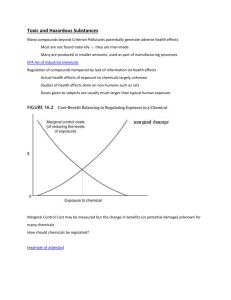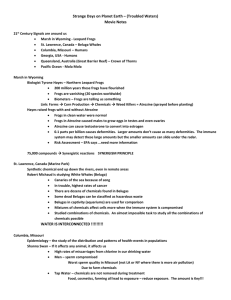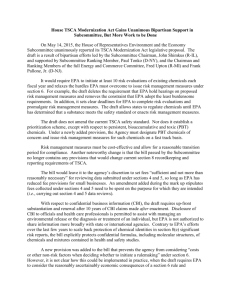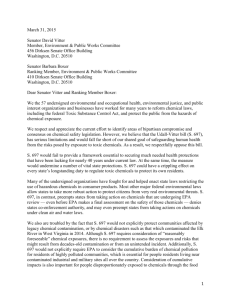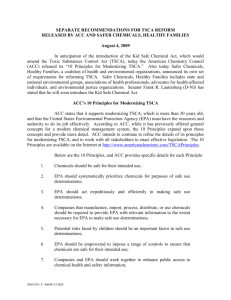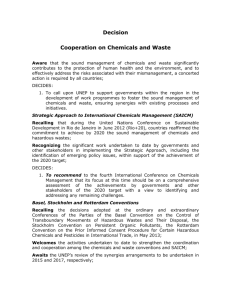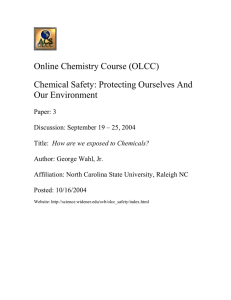Chemical storage and waste HASTI PowerPoint
advertisement
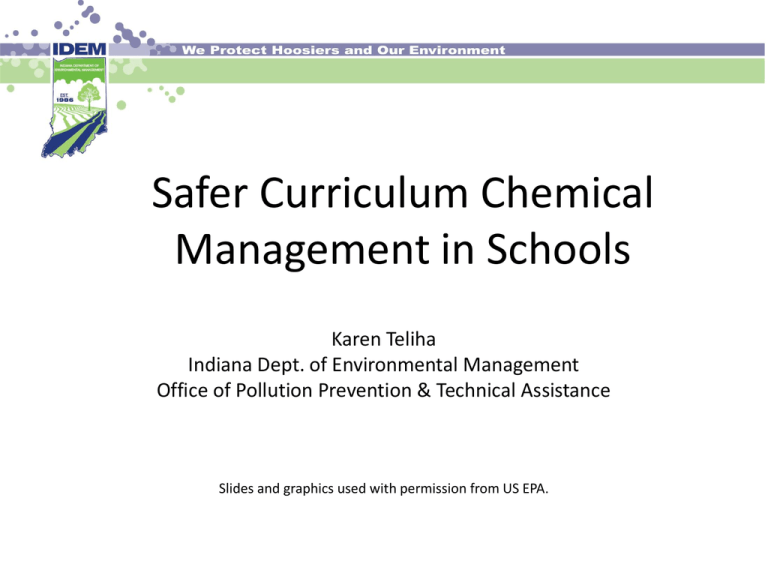
Safer Curriculum Chemical Management in Schools Karen Teliha Indiana Dept. of Environmental Management Office of Pollution Prevention & Technical Assistance Slides and graphics used with permission from US EPA. Think your school lab is safe? • Are You Sure? – Unlabeled “Mystery” Chemicals – Heavy Containers on High Shelves – Outdated Chemicals – Incompatible Storage (corrosives on metal/flammables on wood) – Unlocked/Easily Accessible Storage Why might schools have difficulty properly managing chemicals? • Lack of training • Lack of system • Lack of “somebody in charge” (add-on duty) • Inherited chemicals • Spend it or lose it monies • Lack of communication across Academic, Administrative, & Facilities departments • Facilities often not built for handling chemicals (ventilation, storage problems) • Lack of funds/planning for disposal costs Chemical Storage • What you may be doing now… – Storing Chemicals Alphabetically – Could result in incompatible chemicals stored next to each other • A safer alternative… – Storing by Chemical Group – All nitrates together, sulfates together (can be alphabetical within their groups) Alphabetical Storage – Problems with Incompatibility Incompatible Storage Shelves Chemical Inventory • Having a good inventory system helps to properly manage/maintain a safer lab. – By knowing what you have, you can use it more efficiently – Helps teachers track what they use each year versus what can be disposed of – Helps teachers organize chemicals by their properties (flammability, reactivity, acids) Material Safety Data Sheets • Recommend a binder • A copy in the lab • A copy in the school office Labeling Stockpiling/Overpurchasing The Dirty Dozen • • • • • • Barium chloride Benzene Carbon disulfide Carbon tetrachloride Cyanide compounds Formaldehyde • Hydrofluoric acid • Mercury & compounds • Picric acid • Potassium metal • Sodium metal • Thermit Mercury • Remove from your school lab: – Bulk Mercury – Mercury Containing Equipment (thermometers) • Call Emergency Response if a Mercury Spill is suspected: – 1-888-233-7745 outside 317 Area Code 233-7745 inside 317 Area Code Unlocked Storage Longer Term Goals 1. Develop a chemical management system – Purchase – Storage, including labeling – Use, including labeling – Disposal – Emergency Planning – spills, explosions, accidents 2. Use safer chemicals & less too – Order min quantities, consistent with use – Try to keep only 1 year’s worth stock – Prohibit certain chemicals, period. (hazard potential outweighs educational potential?) 3. Order “safer” alternatives, packaging, dilutions, kits – Green chemistry – Microscale approaches (e.g. spot plates instead of test tubes) 4. Centralize inventory/purchasing 5. Regularly budget for removals (Cradle to grave) 6. Address chemical issues in context with other environmental concerns - As science teachers, it’s important we’re not only teaching chemistry/biology, but also teaching about being safe. Resources • School Chemistry Laboratory Safety Guide, Consumer Product Safety Commission, www.cpsc.gov, • Material Safety Data Sheets www.siri.org/ • Flinn Scientifc www.flinnsci.com/ • Council of State Science Supervisors – Making the Connection – Science Safety: It’s Elementary – www.csss-science.org/safety.htm • Rehab the Lab, Safe labs that don’t pollute www.govlink.org/hazwaste/schoolyouth/reha b/ • EPA’s School Chemical Cleanout Campaign www.epa.gov/sc3 • EPA’s Healthy School Web Portal www.epa.gov/schools • EPA’s Mercury Web Site www.epa.gov/mercury • Mercury in Schools Project www.mercuryinschools.uwex.edu/

